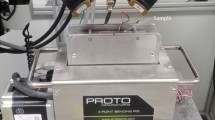Abstract
Dimensional and finite element analyses were used to analyze the relationship between the mechanical properties and instrumented indentation response of materials. Results revealed the existence of a functional dependence of (engineering yield strength σE,y + engineering tensile strength σE,b)/Oliver & Pharr hardness on the ratio of reversible elastic work to total work obtained from an indentation test. The relationship links up the Oliver & Pharr hardness with the material strengths, although the Oliver & Pharr hardness may deviate from the true hardness when sinking in or piling up occurs. The functional relationship can further be used to estimate the sum σE,y + σE,b according to the data of an instrumented indentation test. The σE,y + σE,b value better reflects the strength of a material compared to the hardness value alone. The method was shown to be effective when applied to aluminum alloys. The relationship can further be used to estimate the fatigue limits, which are usually obtained from macroscopic fatigue tests in different modes.
Similar content being viewed by others
References
D. Tabor: The Hardness of Metals (Oxford, London, UK, 2000), pp. 104–106.
Y.T. Cheng, C.M. Cheng: Scaling approach to conical indentation in elastic-plastic solids with work hardening. J. Appl. Phys. 84, 1284 (1998).
M. Dao, N. Chollacoop, K.J. Van Vliet, T.A. Venkatesh, S. Suresh: Computational modeling of the forward and reverse problems in instrumented sharp indentation. Acta Mater. 49, 3899 (2001).
A.E. Giannakopoulos, S. Suresh: Determiniation of elastoplastic properties by instrumented sharp indentation. Scripta Mater. 40, 1191 (1999).
K. Zeng, C.H. Chiu: An analysis of load-penetration curves from instrumented indentation. Acta Mater. 49, 3539 (2001).
Y.T. Cheng, C.M. Cheng: Can stress–strain relationships be obtained from indentation curves using conical and pyramidal indenters? J. Mater. Res. 14, 3493 (1999).
T.W. Capehart, Y.T. Cheng: Determining constitutive models from conical indentation: Sensitivity analysis. J. Mater. Res. 18, 827 (2003).
K.K. Tho, S. Swaddiwudhipong, Z.S. Liu, K. Zeng, J. Hua: Uniqueness of reverse analysis from conical indentation tests. J. Mater. Res. 19, 2498 (2004).
J.L. Bucaille, S. Stauss, E. Felder, J. Michler: Determination of plastic properties of metals by instrumented indentation using different sharp indenters. Acta Mater. 51, 1663 (2003).
Y. Cao, X. Qian, J. Lu, Z. Yao: An energy-based method to extract plastic properties of metal materials from conical indentation tests. J. Mater. Res. 20, 1194 (2005).
W.C. Oliver, G.M. Pharr: An improved technique for determining hardness and elastic modulus using load and displacement sensing indentation experiments. J. Mater. Res. 7, 1564 (1992).
G.M. Pharr, W.C. Oliver, F.R. Brotzen: On the generality of the relationship among contact stiffness, contact area, and elastic modulus during indentation. J. Mater. Res. 7, 613 (1992).
W.C. Oliver, G.M. Pharr: Measurement of hardness and elastic modulus by instrumented indentation: Advances in understanding and refinements to methodology. J. Mater. Res. 19, 3 (2004).
ABAQUS Version 6.2 (Hibbitt, Karlsson & Sorensen, Inc., Pawtucket, RI, 2001).
D. Ma, T. Zhang, C.W. Ong: Evaluation of effectiveness of representative methods for determining Young’s modulus and hardness from instrumented indentation data. J. Mater. Res. 21, 225 (2006).
D. Ma, C.W. Ong, S.F. Wong: New relationship between Young’s modulus and nonideally sharp indentation parameters. J. Mater. Res. 19, 2144 (2004).
D. Ma, C.W. Ong, J. Lu, J. He: Methodology for the evaluation of yield strength and hardening behavior of metallic materials by indentation with spherical tip. J. Appl. Phys. 94, 288 (2003).
Y. Song: Design, Selection and Prediction of Metallic Materials (Mechanical Industry Press, Beijing, China, 1998), p. 443.
H. Xu: Design of Fatigue Strength (Mechanical Industry Press, Beijing, China, 1981), p. 45 (in Chinese).
M. Li, O. Buxbaum, H. Lowak: Structure Design Against Fatigue (Mechanical Industry Press, Beijing, China, 1987), p. 31 (in Chinese).
Author information
Authors and Affiliations
Corresponding author
Rights and permissions
About this article
Cite this article
Ma, D., Zhang, T. & Ong, C.W. Revelation of a functional dependence of the sum of two uniaxial strengths/hardness on elastic work/total work of indentation. Journal of Materials Research 21, 895–903 (2006). https://doi.org/10.1557/jmr.2006.0111
Received:
Accepted:
Published:
Issue Date:
DOI: https://doi.org/10.1557/jmr.2006.0111




